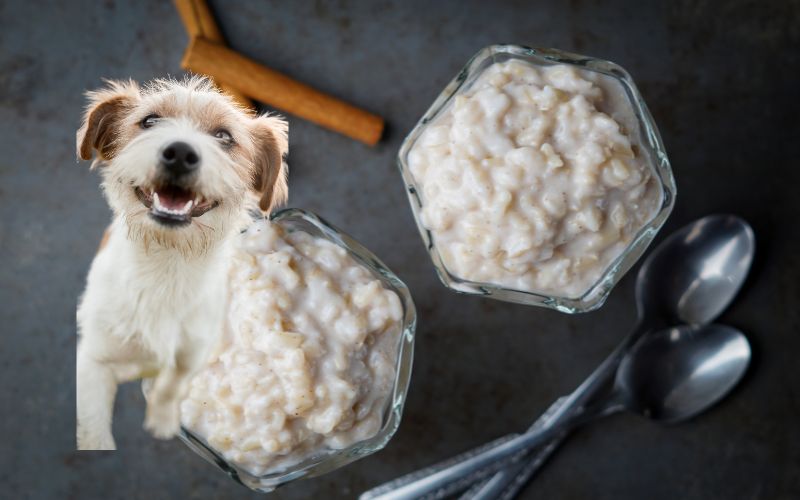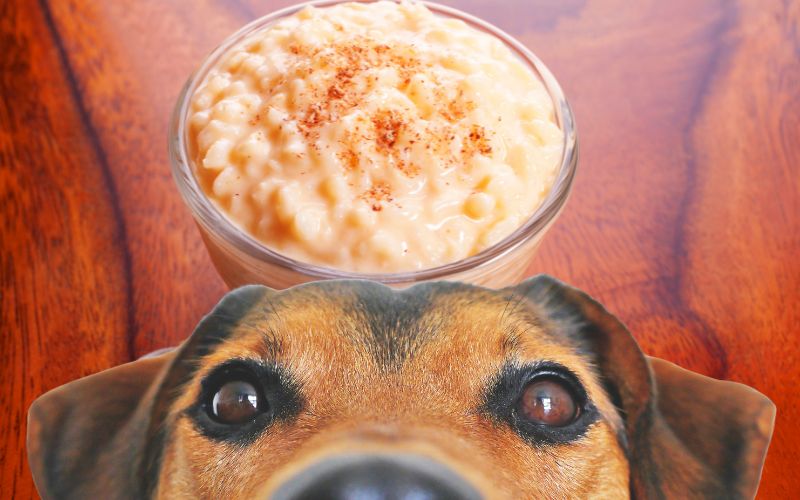The answer is yes, but with some caveats.
First, make sure the rice pudding doesn’t contain raisins or grapes, as these can be toxic to dogs. Second, avoid giving your dog too much rice pudding at once, as it can cause an upset stomach. Finally, things such as sugar and honey should also be avoided, as they can lead to weight gain and other health problems.
What is rice pudding?
Rice pudding is a delightful dessert that’s widely enjoyed in various forms across the world. In its most basic form, it’s made by simmering rice with milk and sugar.
Often, it’s flavoured with ingredients like vanilla, cinnamon, and nutmeg. Some recipes also include eggs, which give the pudding a custard-like texture.
In the UK, rice pudding is traditionally made with pudding rice, milk, sugar, and often a pinch of nutmeg sprinkled on top.
It can be made on the hob (stovetop) or in the oven. The oven-baked version tends to develop a delicious skin on top, which is cherished by some and peeled off by others.
It’s often enjoyed as is, but can also be served with a dollop of jam, a sprinkling of sugar, or a dash of cinnamon.
Different cultures have their own variations of rice pudding.
For instance, in Scandinavia, rice pudding might be served with a cherry sauce and be enjoyed at Christmas, while in India, a version called kheer is made with cardamom and often garnished with nuts and raisins.
How much rice pudding can a dog have?
As with any treat, it’s important to give your dog rice pudding in moderation.
Too much of any kind of food can cause an upset stomach, so start with a small amount and see how your dog reacts.
If they seem to enjoy it and have no digestive issues, you can slowly increase the amount you give them.
Just be sure to keep an eye on their waistline; too many treats can lead to weight gain and other health problems.

Are there any risks associated with feeding dogs rice pudding?
Yes, there are some risks associated with feeding dogs rice pudding.
First, as mentioned before, raisins and grapes are toxic to dogs and should be avoided.
Some rice puddings can contain artificial sweeteners, many of which are toxic to dogs and which can lead to serious illness if ingested.
Flavoured rice puddings will also often contain additional ingredients which are unsuitable and often unsafe for dogs to consume.
Finally, feeding your dog too much rice pudding at once can cause an upset stomach. If you’re unsure about whether rice pudding is safe for your dog, talk to your veterinarian.
Should you give rice pudding to dogs?
It’s generally not recommended to give rice pudding to dogs.
While plain cooked rice can be safe for dogs in moderation, rice pudding typically contains additional ingredients that aren’t suitable for canine consumption.
Here are a few reasons why rice pudding might not be the best treat for dogs:
Sugar: Rice pudding usually contains sugar, which is not healthy for dogs and can lead to obesity and dental problems.
Dairy: Many dogs are lactose intolerant to some degree, which means they can have difficulty digesting milk and other dairy products, potentially leading to gastrointestinal upset.
Spices: Spices like nutmeg, which is sometimes used in rice pudding, can be toxic to dogs.
Raisins: Some rice pudding recipes might include raisins, which are highly toxic to dogs and can cause kidney failure.
If you wish to give your dog a special treat, consider offering them something that is known to be safe for dogs to consume, like a small piece of carrot or a specially formulated dog treat.
Always consult with your vet if you’re unsure about giving your dog any type of human food.
DOG SAFE RICE PUDDING RECIPE
Here’s a simplified, dog-safe rice pudding recipe.
Remember that treats and special foods should only make up about 10% of your dog’s daily caloric intake, and always introduce new foods gradually to monitor for any adverse reactions.
Dog-Safe Rice Pudding
Ingredients:
100g of rice (choose a plain, white rice)
500ml of water
1 small carrot, finely grated
1 apple, peeled, cored, and finely grated (ensure no seeds are included)
Optional: a small amount of cooked chicken or turkey, shredded
Method:
Cook the Rice:
Rinse the rice thoroughly under cold water.
In a medium-sized saucepan, bring the 500ml of water to a boil.
Add the rice to the boiling water, reduce the heat, cover, and simmer for about 15-20 minutes, or until the rice is cooked and has absorbed the water.
Prepare the Add-Ins:
While the rice is cooking, peel and grate the carrot and apple. Ensure the apple is thoroughly cored and seeded to avoid any toxic parts.
If you’re using chicken or turkey, ensure it is well-cooked and shredded into small, manageable pieces for your dog.
Combine Ingredients:
Once the rice is cooked, remove it from the heat and let it cool to a safe temperature for your dog.
Mix in the grated carrot and apple, ensuring they are well-distributed throughout the rice.
If you’re using meat, mix this in thoroughly as well.
Serve:
Ensure the pudding is at room temperature or only slightly warm before serving it to your dog.
Offer a small portion in your dog’s dish, observing them to ensure they enjoy it and do not have any adverse reactions.
Store:
Store any leftover rice pudding in an airtight container in the fridge for up to three days.
You can also portion it into ice cube trays and freeze it, offering it as a cool treat on warmer days.
Notes:
Always introduce new foods to your dog’s diet gradually and monitor for any signs of allergies or upset stomach.
Ensure all ingredients are suitable for your individual dog, especially if they have known allergies or dietary restrictions.
Always consult with your vet before introducing new foods to your dog’s diet, especially if they have any health conditions.
FAQs
Can dogs eat rice pudding?
In moderation, dogs can eat rice pudding, but it’s not typically recommended as a regular part of their diet. It should be offered as an occasional treat only.
What are the potential risks associated with dogs eating rice pudding?
Rice pudding is often made with ingredients such as sugar, milk, and various flavourings that aren’t ideal for dogs. Too much sugar can lead to obesity, dental issues, and even diabetes. Dogs can also be lactose intolerant, causing stomach upset after consuming dairy products like milk.
Can dogs have a negative reaction to rice pudding?
Yes, dogs can have negative reactions if they eat too much rice pudding or if they are sensitive or allergic to any of its ingredients. Signs of a reaction can include vomiting, diarrhea, excessive gas, and lethargy. If you observe these symptoms after your dog consumes rice pudding, contact your vet immediately.
Is there a safe way to give my dog rice pudding?
If you decide to give your dog rice pudding, it should be plain (no added sugar, spices, or flavourings) and served in very small amounts. But it’s always best to consult with your vet first before introducing new foods into your pet’s diet.
Are there healthier alternatives to rice pudding for dogs?
Yes, instead of rice pudding, consider giving your dog plain cooked rice or other dog-safe fruits and vegetables. These options are typically healthier and easier for dogs to digest. Always remember to introduce new foods gradually to avoid any potential digestive issues.
Final Words
Rice pudding can be safe for dogs to eat, in moderation but you shouldn’t make a habit of letting your dog eat it.
While there are some health risks associated with feeding dogs rice pudding, these can be avoided by sticking to plain, unsweetened rice pudding and avoiding giving your dog too much at once.
If you’re unsure whether rice pudding is suitable for your dog, then the best option is to avoid feeding it to them altogether.
If you do decide to give your dog rice pudding, always keep an eye on them afterwards in case they have any adverse reaction.
And as with anything, if you’re ever in doubt, consult your veterinarian.




